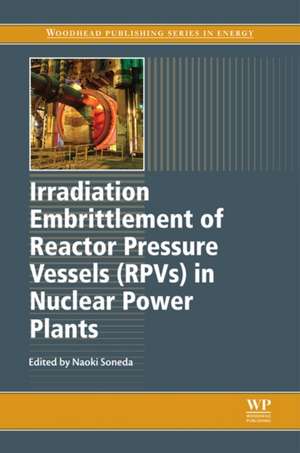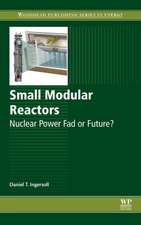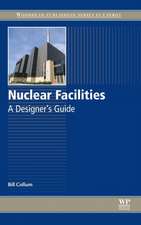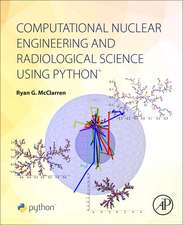Irradiation Embrittlement of Reactor Pressure Vessels (RPVs) in Nuclear Power Plants: Woodhead Publishing Series in Energy
Editat de Naoki Sonedaen Limba Engleză Hardback – 21 aug 2014
Part I reviews RPV design and fabrication in different countries, with an emphasis on the materials required, their important properties, and manufacturing technologies. Part II then considers RVP embrittlement in operational nuclear power plants using different reactors. Chapters are devoted to embrittlement in light-water reactors, including WWER-type reactors and Magnox reactors. Finally, Part III presents techniques for studying embrittlement, including irradiation simulation techniques, microstructural characterisation techniques, and probabilistic fracture mechanics.
Irradiation Embrittlement of Reactor Pressure Vessels (RPVs) in Nuclear Power Plants provides a thorough review of an issue that is central to the safety of nuclear power generation. The book includes contributions from an international team of experts, and will be a useful resource for nuclear plant operators and managers, relevant regulatory and safety bodies, nuclear metallurgists and other academics in this field
- Discusses reactor pressure vessel (RPV) design and the effect irradiation embrittlement can have, the main degradation mechanism affecting RPVs
- Examines embrittlement processes in RPVs in different reactor types, as well as techniques for studying RPV embrittlement
Din seria Woodhead Publishing Series in Energy
-
 Preț: 1005.08 lei
Preț: 1005.08 lei -
 Preț: 853.22 lei
Preț: 853.22 lei - 24%
 Preț: 1307.96 lei
Preț: 1307.96 lei - 24%
 Preț: 1209.19 lei
Preț: 1209.19 lei - 24%
 Preț: 1386.95 lei
Preț: 1386.95 lei - 9%
 Preț: 900.25 lei
Preț: 900.25 lei - 9%
 Preț: 1067.83 lei
Preț: 1067.83 lei - 29%
 Preț: 1071.46 lei
Preț: 1071.46 lei - 9%
 Preț: 950.40 lei
Preț: 950.40 lei - 29%
 Preț: 1071.13 lei
Preț: 1071.13 lei - 9%
 Preț: 1011.50 lei
Preț: 1011.50 lei - 9%
 Preț: 1309.35 lei
Preț: 1309.35 lei - 39%
 Preț: 1047.65 lei
Preț: 1047.65 lei - 9%
 Preț: 949.23 lei
Preț: 949.23 lei - 24%
 Preț: 1688.64 lei
Preț: 1688.64 lei - 9%
 Preț: 1344.70 lei
Preț: 1344.70 lei - 9%
 Preț: 1049.56 lei
Preț: 1049.56 lei - 27%
 Preț: 1923.12 lei
Preț: 1923.12 lei - 23%
 Preț: 1519.01 lei
Preț: 1519.01 lei - 23%
 Preț: 1074.68 lei
Preț: 1074.68 lei - 29%
 Preț: 981.24 lei
Preț: 981.24 lei - 9%
 Preț: 1397.24 lei
Preț: 1397.24 lei - 39%
 Preț: 1397.48 lei
Preț: 1397.48 lei - 9%
 Preț: 945.89 lei
Preț: 945.89 lei - 9%
 Preț: 1514.09 lei
Preț: 1514.09 lei - 9%
 Preț: 1073.87 lei
Preț: 1073.87 lei - 9%
 Preț: 1020.23 lei
Preț: 1020.23 lei - 39%
 Preț: 880.81 lei
Preț: 880.81 lei - 9%
 Preț: 950.94 lei
Preț: 950.94 lei - 39%
 Preț: 1225.96 lei
Preț: 1225.96 lei - 9%
 Preț: 1214.08 lei
Preț: 1214.08 lei - 39%
 Preț: 1085.98 lei
Preț: 1085.98 lei - 9%
 Preț: 868.43 lei
Preț: 868.43 lei - 24%
 Preț: 1615.93 lei
Preț: 1615.93 lei - 24%
 Preț: 1077.86 lei
Preț: 1077.86 lei - 9%
 Preț: 946.04 lei
Preț: 946.04 lei - 9%
 Preț: 952.05 lei
Preț: 952.05 lei - 9%
 Preț: 1165.33 lei
Preț: 1165.33 lei - 24%
 Preț: 1307.96 lei
Preț: 1307.96 lei - 29%
 Preț: 1213.47 lei
Preț: 1213.47 lei - 24%
 Preț: 1075.25 lei
Preț: 1075.25 lei - 24%
 Preț: 1048.44 lei
Preț: 1048.44 lei - 29%
 Preț: 1454.22 lei
Preț: 1454.22 lei - 39%
 Preț: 1285.27 lei
Preț: 1285.27 lei - 9%
 Preț: 952.68 lei
Preț: 952.68 lei - 23%
 Preț: 878.04 lei
Preț: 878.04 lei - 9%
 Preț: 951.98 lei
Preț: 951.98 lei - 9%
 Preț: 1209.42 lei
Preț: 1209.42 lei
Preț: 927.68 lei
Preț vechi: 1350.02 lei
-31% Nou
Puncte Express: 1392
Preț estimativ în valută:
177.67€ • 183.05$ • 148.83£
177.67€ • 183.05$ • 148.83£
Carte tipărită la comandă
Livrare economică 15 februarie-01 martie
Preluare comenzi: 021 569.72.76
Specificații
ISBN-13: 9781845699673
ISBN-10: 184569967X
Pagini: 432
Dimensiuni: 156 x 234 x 30 mm
Greutate: 0.79 kg
Ediția:New.
Editura: ELSEVIER SCIENCE
Seria Woodhead Publishing Series in Energy
ISBN-10: 184569967X
Pagini: 432
Dimensiuni: 156 x 234 x 30 mm
Greutate: 0.79 kg
Ediția:New.
Editura: ELSEVIER SCIENCE
Seria Woodhead Publishing Series in Energy
Public țintă
Nuclear plant operators and managers, relevant regulatory and safety bodies, nuclear metallurgists and other academics in this field.Cuprins
- Contributor contact details
- Woodhead Publishing Series in Energy
- Preface
- Part I: Reactor pressure vessel (RPV) design and fabrication
- 1: Reactor pressure vessel (RPV) design and fabrication: the case of the USA
- Abstract
- 1.1 Introduction
- 1.2 American Society of Mechanical Engineers (ASME) Code design practices
- 1.3 The design process
- 1.4 Reactor pressure vessel (RPV) materials selection
- 1.5 Toughness requirements
- 1.6 RPV fabrication processes
- 1.7 Welding practices
- 2: Reactor pressure vessel (RPV) components: processing and properties
- Abstract
- 2.1 Introduction
- 2.2 Advances in nuclear reactor pressure vessel (RPV) components
- 2.3 Materials for nuclear RPVs
- 2.4 Manufacturing technologies
- 2.5 Metallurgical and mechanical properties of components
- 2.6 Conclusions
- 3: WWER-type reactor pressure vessel (RPV) materials and fabrication
- Abstract
- 3.1 Introduction
- 3.2 WWER reactor pressure vessel (RPV) materials
- 3.3 Production of materials for components and welding techniques
- 3.4 Future trends
- 1: Reactor pressure vessel (RPV) design and fabrication: the case of the USA
- Part II: Reactor pressure vessel (RPV) embrittlement in operational nuclear power plants
- 4: Embrittlement of reactor pressure vessels (RPVs) in pressurized water reactors (PWRs)
- Abstract
- 4.1 Introduction
- 4.2 Characteristics of pressurized water reactor (PWR) reactor pressure vessel (RPV) embrittlement
- 4.3 US surveillance database
- 4.4 French surveillance database
- 4.5 Japanese surveillance database
- 4.6 Surveillance databases from other countries
- 4.7 Future trends
- 5: Embrittlement of reactor pressure vessels (RPVs) in WWER-type reactors
- Abstract
- 5.1 Introduction
- 5.2 Characteristics of embrittlement of WWER reactor pressure vessel (RPV) materials
- 5.3 Trend curves
- 5.4 WWER surveillance programmes
- 5.5 RPV annealing in WWER reactors
- 5.6 RPV annealing technology
- 5.7 Sources of further information and advice
- 6: Integrity and embrittlement management of reactor pressure vessels (RPVs) in light-water reactors
- Abstract
- 6.1 Introduction
- 6.2 Parameters governing reactor pressure vessel (RPV) integrity
- 6.3 Pressure–temperature operating limits
- 6.4 Pressurized thermal shock (PTS)
- 6.5 Mitigation methods
- 6.6 Licensing considerations
- 7: Surveillance of reactor pressure vessel (RPV) embrittlement in Magnox reactors
- Abstract
- 7.1 Introduction
- 7.2 History of Magnox reactors
- 7.3 Reactor pressure vessel (RPV) materials and construction
- 7.4 Reactor operating rules
- 7.5 Design of the surveillance schemes
- 7.6 Early surveillance results
- 7.7 Dose–damage relationships and intergranular fracture in irradiated submerged-arc welds (SAWs)
- 7.8 Influence of thermal neutrons
- 7.9 Validation of toughness assessment methodology by RPV SAW sampling
- 7.10 Final remarks
- 7.11 Acknowledgements
- 4: Embrittlement of reactor pressure vessels (RPVs) in pressurized water reactors (PWRs)
- Part III: Techniques for the evaluation of reactor pressure vessel (RPV) embrittlement
- 8: Irradiation simulation techniques for the study of reactor pressure vessel (RPV) embrittlement
- Abstract
- 8.1 Introduction
- 8.2 Test reactor irradiation
- 8.3 Ion irradiation
- 8.4 Electron irradiation
- 8.5 Advantages and limitations
- 8.6 Future trends
- 8.7 Sources of further information and advice
- 9: Microstructural characterisation techniques for the study of reactor pressure vessel (RPV) embrittlement
- Abstract
- 9.1 Introduction
- 9.2 Microstructural development and characterisation techniques
- 9.3 Transmission electron microscopy (TEM)
- 9.4 Small-angle neutron scattering (SANS)
- 9.5 Atom probe tomography (APT)
- 9.6 Positron annihilation spectroscopy (PAS)
- 9.7 Auger electron spectroscopy (AES)
- 9.8 Other techniques
- 9.9 Using microstructural analyses to understand the mechanisms of reactor pressure vessel (RPV) embrittlement
- 9.10 Grain boundary segregation
- 9.11 Matrix damage
- 9.12 Solute clusters
- 9.13 Mechanistic framework to develop dose–damage relationships (DDRs)
- 9.14 Recent developments and overall summary
- 10: Evaluating the fracture toughness of reactor pressure vessel (RPV) materials subject to embrittlement
- Abstract
- 10.1 Introduction
- 10.2 The development of fracture mechanics
- 10.3 Plane-strain fracture toughness and crack-arrest toughness
- 10.4 Current standard of fracture toughness curve
- 10.5 Effects of irradiation on fracture toughness
- 10.6 Fracture toughness versus Charpy impact energy
- 10.7 Heavy Section Steel Technology Program and other international reactor pressure vessel (RPV) research programs
- 10.8 Advantages and limitations of fracture toughness testing
- 10.9 Future trends
- 11: Embrittlement correlation methods to identify trends in embrittlement in reactor pressure vessels (RPVs)
- Abstract
- 11.1 Introduction
- 11.2 Development of the embrittlement correlation method
- 11.3 Embrittlement correlation methods: USA
- 11.4 Embrittlement correlation methods: Europe
- 11.5 Embrittlement correlation methods: Japan
- 11.6 Conclusions
- 12: Probabilistic fracture mechanics risk analysis of reactor pressure vessel (RPV) integrity
- Abstract
- 12.1 Introduction
- 12.2 Risk evaluation procedures for assessing reactor pressure vessel (RPV) integrity
- 12.3 Probabilistic fracture mechanics analysis software
- 12.4 Conditional probability computational procedure
- 12.5 Example calculations and applications
- 12.6 Future trends
- 8: Irradiation simulation techniques for the study of reactor pressure vessel (RPV) embrittlement
- Index
















